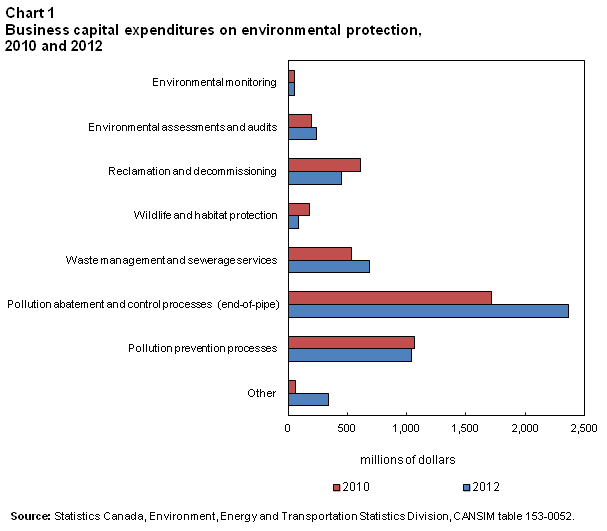Environmental protection expenditures by businesses – 2012
GLOBE-Net, May 5, 2015 – Canadian businesses reported that they spent $10.9 billion on environmental protection in 2012, up 15% from 2010 according to a new report from Statistics Canada.
Two categories of expenditures—pollution abatement and control processes, and waste management and sewerage services—accounted for just over half the total reported in the 2012 Survey of Environmental Protection Expenditures.
End of pipe solutions are in the rise, while systems integration spending on pollution prevention actually declined by 3% over the same period.
The oil and gas extraction industry reported spending $4.7 billion or 43% of total business environmental protection expenditures. This was the most among the 16 industry groups surveyed.
The mining and quarrying industry followed, spending $1.4 billion or 12% of total expenditures, while the electric power generation, transmission and distribution industry spent just over $1.3 billion in 2012.
Provincially, businesses in Alberta reported the highest spending on environmental protection at just over $5.0 billion. This was largely attributable to the high concentration of the oil and gas extraction industry in the province.
Capital expenditures
Of the $10.9 billion in total environmental protection spending, capital expenses accounted for $5.3 billion, up 19% from 2010. Operating expenses, in turn, accounted for $5.7 billion, up 11%.
Capital spending in the oil and gas extraction industry totalled $2.6 billion on environmental protection projects, up 13% from 2010. This accounted for 49% of the total.
Capital expenditures on environmental protection
Businesses in Canada increased their investment in environmental protection, reporting $5.3 billion in capital expenditures for environmental protection in 2012, an increase of 19% from 2010 (Chart 1), continuing an upward trend that started in 2008 (Chart 2).
The largest share of environmental protection capital investments were for pollution abatement and control (45%) followed by pollution prevention (20%). These two activities have received the largest share of investments in each survey cycle since 2006.
By category of capital expenditure, pollution abatement and control processes (end-of-pipe) showed the largest change in capital investment at a 38% increase from 2010 to 2012 (from $1.7 billion to $2.4 billion), while investment in pollution prevention activities decreased by 3% over the same period (from $1.1 billion to $1.0 billion).
Increased capital investment can also be seen in the waste management and sewerage category. Investment in all other environmental protection expenditure categories (with the exception of those investments classified in the “environmental assessments and audits” and “other” categories) decreased from 2010 to 2012.
Capital spending by industry
Capital investments in environmental protection by the oil and gas extraction industry totalled $2.6 billion in 2012, an increase of 13% from 2010. This industry was responsible for the highest amount of capital expenditure from 2006 to 2012. Businesses in the oil and gas extraction industry increased their investments in pollution abatement and control processes, pollution prevention processes, waste management and sewerage, and other activities from 2010 to 2012.
The mining and quarrying industry also reported increased investments in environmental protection activities for 2012 compared to 2010. This industry directed most of its investments to pollution abatement and control processes (end-of-pipe) (60%). This was largely due to sizeable exploration activities in 2012.
Investment in pollution abatement and control accounted for 45% of total capital investment, followed by pollution prevention, which represented 20%. These two activities have received the largest share of investments in each survey cycle since 2006.
Operating expenditures
As in previous years, the largest share of operating expenses was for waste management and sewerage services. In 2012, businesses spent $1.6 billion on these services, representing 27% of total operating expenditures on environmental protection.
The oil and gas extraction industry reported the highest environmental protection operating expenditures at $2.2 billion, or 38% of the total.
Spending on renewable energy and on greenhouse gas emission mitigation
Capital investments in renewable energy technologies totalled $547 million, up 20% from 2010. Investment was highest in biomass energy technologies, which accounted for more than half of the total in renewable energy technologies.
In addition, about 12% of businesses surveyed reported they had conducted a greenhouse gas emissions inventory, up from 10% of businesses in 2010.
Industrial research and development spending falling
In a related release Statistic Canada reports a significant drop in planned expenditure intentions on research and development.
The latest report on spending intentions on industrial research and development notes businesses in Canada anticipate spending $15.5 billion to perform research and development (R&D) in 2015, down 2.6% from 2014 intentions of $15.9 billion and 3.6% lower than the actual expenditures of $16.0 billion in 2013.
The top four fields of engineering and technology accounted for two-thirds of all industrial R&D in Canada in 2013: electrical engineering, electronic engineering and information technology ($3.5 billion); other engineering and technology ($2.7 billion); software engineering ($2.6 billion) and mechanical engineering ($2.0 billion).
R&D spending in emerging technologies, such as biotechnology (not including big pharma) and nanotechnology, was $404 million or 3% of industrial R&D in 2013.
Energy-related research and development
Businesses in Canada spent $2.0 billion on energy-related R&D in 2013, unchanged from 2012. Fossil fuel-related R&D performance accounted for over two-thirds of all energy-related R&D in 2013 at $1.4 billion, down slightly from $1.5 billion in 2012.
By comparison R&D spending for energy efficiency-related technologies reached only $128 million in 2013, up from $80 million in 2012.





